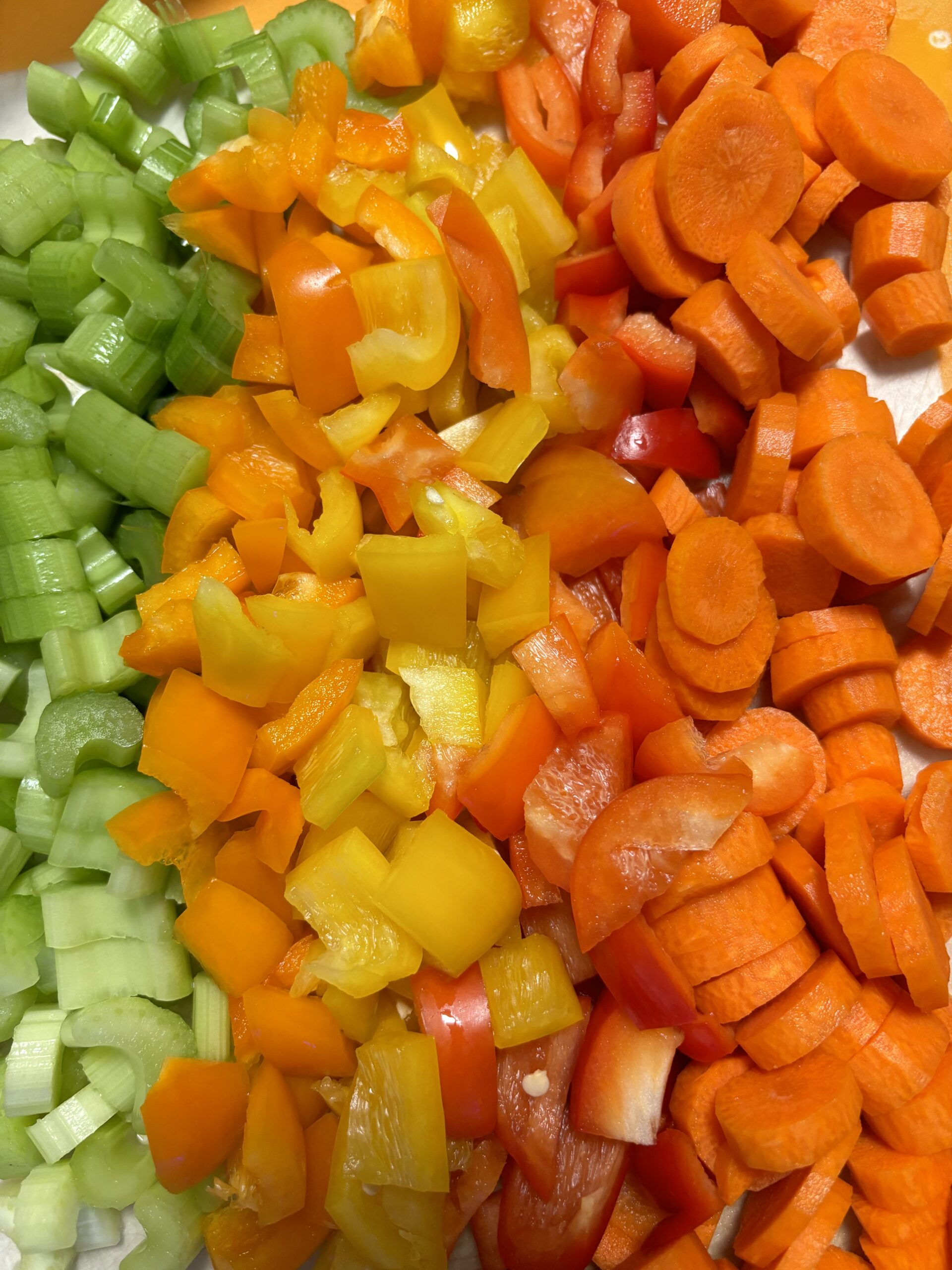Is eating organic food a sham?
I started purchasing primarily organic food in 2021. While I had been eating healthy Whole30 meals for a few years, I previously only purchased conventional food. It was cheaper, and to be honest, I thought “eating organic” was a sham. In 2021 there were some influencers I was following on Instagram that started to share information about women’s hormones, non-toxic living, and functional medicine. I was really skeptical, but one influencer shared about a book called “Woman Code” by Alisa Vitti. She shared how much she learned about her female body and hormones by reading this book. Immediately I was intrigued. I bought the book, and I learned so much about the female body and how it works!! I kept thinking – how have I gone through 27 years of life without knowing this about my body?

Vitti makes a lot of dietary recommendations to help balance your hormones. I had already found out that gluten and dairy were not my dietary “friends” so to speak through my Whole30 and healthy eating journey and had already mostly eliminated them from my daily diet. Another guideline within the book was around eliminating endocrine-disrupting chemicals. She had just finished talking about how important the endocrine system is, so it made a lot of sense to eliminate items that could disrupt it. I started making changes in 2021 by swapping to a more natural deodorant. Then I moved on to finding a new skin care line, and new laundry detergent, among others. Those changes took a while to implement because I didn’t want to immediately replace everything in my house. I wanted to be responsible wait until I had run out of my current items.
My personal experience with switching to primarily organic foods
The one thing I could change immediately was buying organic food. I had no idea so many pesticides were considered endocrine disruptors. I never had testing done to indicate my hormones were out of balance, but Vitti’s book convinced me to take a deeper look at my environment’s influence on my health. Once I made these changes consistently, I noticed a huge impact on my period. My period used to be very difficult to manage. Despite using the highest absorbency tampon I often needed to change it every 1-2 hours for the first three days. I always had terrible cramps as well.
Over time as I continued to replace more personal care items and continued to prioritize organic food, I can now wear a mid-absorbency tampon for hours even on the heaviest day. My cramps are still there, but significantly less intense than before. Since I started making personal care product changes at the same time, I can’t really trace this improvement back to one single thing. It’s likely a compounding effect of all the personal care items and organic food changes. This is my personal story of why I started eating organic foods, and why I continue to choose organic. While I always want to share my personal reasons for making the changes I do, let’s also dig into the research!
Organic vs. conventional: pesticides
One of my primary reasons for choosing organic foods is for my health. Let’s first look at exposure to pesticides, antibiotics, and other materials of concern. Contrary to popular belief, organic farming can use pesticides. However, the list of allowable pesticides is significantly shorter when comparing to conventional farming. To learn more about the requirements of organic farming and labeling in the United States, check out this post about organic farming. At a high level over 350 substances are permitted as pesticides for conventional agriculture, whereas a little over 25 are permitted in organic agriculture.
Research has proven that eating an organic diet leads to a lower concentration of urinary pesticide metabolites. Translation: when you eat organic, you consume less pesticides compared to conventional. Research has also proven that switching from conventional to organic foods leads to a quick decrease (a few days to one week) in urinary pesticide metabolites. Translation: if you switch from conventional foods to organic foods, it does not take your body very long to get rid of the pesticides consumed with the conventional food.
Pesticide limits and research gaps
Now just because we know we consume more pesticides with conventional food doesn’t automatically mean it’s terrible for us. There is a significant research gap on the impact of pesticide exposure and how urinary pesticide metabolites correlate to health issues. There are many different pesticides in food production, so we can’t talk about each one in detail. However, each pesticide has a “Maximum Residue Level”, or MRL, that is set by regulatory authorities. In the United States, the USDA completes regular testing on food samples to check if they meet the MRL. Only 0.59% of samples tested by the USDA had pesticide residue above the MRL. USDA testing also found that 27.5% of samples have multiple different pesticides present.
Let’s walk through some of the research gaps.
- Almost 30% of samples tested by the USDA had more than one pesticide present. However, regulations and risk assessments look at individual pesticides without requiring a review of the potential of mixed pesticide exposure.
- Low level chronic exposure to pesticides over time can be very difficult to assess. Long-term, carefully controlled studies are needed to prove a low level chronic exposure effect. Unfortunately, these types of studies are not typically required before a new pesticide is approved for use.
- Research demonstrates that children have a higher concentration of urinary pesticide metabolites than adults. Children have lower body weights which leads to a higher concentration of pesticides in the body. If pesticides pose a health risk, this means it will affect children more seriously than adults. In addition, children are still developing and growing. Pesticide exposure may affect them differently than adults.
- Glyphosate is a common herbicide, and the World Health Organization’s International Agency for Research on Cancer has labeled glyphosate as “probably carcinogenic.” Glyphosate is still used regularly in growing conventional crops. There have been instances where pesticides have been banned retroactively due to negative health effects – will glyphosate be next? The question I’m asking here is, do we really have the right protocols and assessments in place to determine safety BEFORE a pesticide can be used to grow human food? In my personal opinion, the answer is no.
Suspected pesticide effects
Researchers suspect pesticides to be carcinogenic, endocrine-disruptors, and neurotoxic. These are some of the health effects that have caused pesticides to be banned retroactively. Unfortunately there is not enough data available to ban all pesticides.
Research shows that consuming organic food can decrease the risk of multiple medical issues and diseases, such as:
- Risk of being overweight or obese
- Risk of developing non-Hodgkin lymphoma (in women)
- Risk of developing eczema (in infants)
- Risk of developing pre-eclampsia (in pregnant women)
- Risk of pregnancy loss
- Risk of lower IQ in children (when pregnant mothers are exposed to organophosphates)
- Risk of hypertension
- Risk of Type 2 diabetes
Organophosphate and pyrethroid exposure specifically has been linked to developmental delays and attention problems when children have been exposed early in their mother’s pregnancy. This has been studied by evaluating greenhouse and farm workers who were exposed before they knew they were pregnant in Denmark, California, and New York. Most insecticides are designed to negatively affect the nervous systems of insects. The nervous systems of humans and other animals have many similarities to insects. If insecticides are designed to negatively impact the nervous system of insects, then isn’t it plausible it would affect humans nervous systems as well? Especially as humans are extremely young and their nervous systems are still developing?

Confounding factors and research gaps
While some studies have shown associations between eating organic food and a lower risk of certain diseases, there are many research gaps and issues with these studies that should be addressed. Many studies are relatively small with a short duration. Or they are large studies based on participants remembering the frequency of organic product consumption over a long period of time. Additionally, many people who choose to consume organic food typically make healthier lifestyle choices overall. They typically exercise more often, don’t smoke, and eat more fruits and vegetables. It’s difficult to adjust for all of these confounding factors in studies. All of these factors can also affect the development of various diseases.
Organic vs. conventional: nutritional value
The second reason you may want to consider eating organic food is due to the slight positive impact it has on nutrients of the food. The evidence here is even less clear than the evidence around pesticide residue we discussed. There are conflicting studies when it comes to nutrient content of foods. However, most studies agree there is either a slight positive impact or no impact at all of organic farming on the nutritional value of foods.
- Carotenoids, vitamin C, and phenolic compounds have been found to be higher in organic foods compared to conventional in some studies.
- One theory is that nitrogen fertilizer used in conventional production, while it increases yield, decreases phenolic compounds in produce.
- Some studies have found a lower probability of finding mycotoxins (mold) in organic foods compared to conventional.
- Organic dairy products have been found to have a higher concentration of omega-3 fatty acids (the kind we need in our diets!) as well as a higher concentration of ⍺-tocopherol (Vitamin E).
- One theory is that the longer grazing period for organic cattle and the higher percentage of fatty acids in their feed that causes this difference.
- Organic meat products have also been found to have a higher concentration of omega-3 fatty acids for the same reasons as organic dairy products.
- Plasma levels of some carotenoids, some fatty acids, and magnesium were found to be higher in consumers of primarily organic food compared to conventional.
Organic vs. conventional: environmental impacts
Lastly, you may want to consider eating organic food because of the relatively positive environmental impact. As part of reviewing the environmental impact, we will reference The Rodale Institute’s Farming Systems Trial (FST) quite often. This trial has been in progress for 40+ years generating field data in Pennsylvania from plots of land managed in different ways. They farm grains (corn, soy, oats, wheat) and they have three primary practices:
- Conventional farming: uses pesticides (synthetic nitrogen) for crop growth, and uses herbicides for weed control at the rates recommended to farmers in the same geographic area.
- Organic (legume) farming: uses crop rotation and legumes which supply nitrogen to the soil for crop growth, and uses crop rotation and cover crops for weed and pest control.
- Organic (manure) farming: uses crop rotation and manure which supply nitrogen to the soil for crop growth, and uses crop rotation and cover crops for weed and pest control.
The Rodale Institute makes changes to their research plots as farming practices evolve in their region. They have added or adjusted types and amounts of cover crops, changed tilling practices, and incorporated GMO seeds (conventional only).
Biodiversity impact
Organic farming positively impacts biodiversity. Due to crop rotation (not planting the same crop in the same place year after year) and cover crop (crops planted strategically to enhance soil fertility) use which is central to organic farming practices, this allows for more biodiversity on the farm. Minimal pesticide use also encourages local animals to establish their habitats both in and around the crop fields. These increases in biodiversity can also encourage healthy soil due to an increase in diversity of microorganisms.
Soil health impact
This is a great lead into the next point: organic farming positively impacts soil health. Soil health is critical as it provides nutrients to and prevents disease from the food being produced. It also sequesters carbon from the atmosphere. Additionally, healthy soil retains more moisture and prevents runoff from occurring, which in turn prevents soil erosion. Crop rotations (not planting the same crop in the same place year after year), cover crops (crops planted strategically to enhance soil fertility), and minimum tillage (reduction in soil turnover before planting) are all critical to maintaining soil health in an organic system. “Good soil” is indicated by a high level of carbon-containing organic matter, a high diversity of soil microbes, and low soil compaction. Here’s a summary from the Rodale Institute’s FST:
- Carbon-containing organic matter: The organic manure system had a significantly higher level of carbon-containing organic matter when compared to the organic legume system and the conventional system. Tillage practices did not make a difference.
- Diversity of soil microbes: The organic legume system had the highest diversity of soil microbes, while the organic manure system had the highest level of soil microbe activity. Reducing tillage increased microbial activity in the soil.
- Soil compaction: The organic legume and organic manure systems were significantly less compacted than the conventional system. Tillage did not affect the compaction in organic systems, but reduced tillage actually made the conventional system more compact.
Groundwater impact
Organic farming practices lead to healthy soil, which protects groundwater resources. Synthetic pesticides and fertilizers used in conventional agriculture pollute groundwater through leaching, and pollute rivers and lakes from runoff. Glyphosate is a common herbicide in conventional farming. Glyphosate has been found in 40% of freshwater samples and 70% of rainwater samples. This demonstrates its persistence in the environment after application. In organic agriculture, manure is often used instead of synthetic fertilizers. It is certainly possible to contaminate groundwater with manure as well without proper management and application. In general there is less risk for water contamination with manure in comparison to conventional fertilizer methods.
Greenhouse gas emissions impact
The impact of organic farming on greenhouse gas (GHG) emissions is a little bit less clear. The Rodale Institute’s FST shows that organic agriculture reduces energy use by about 45%. Many common pesticides used in conventional agriculture, which provide synthetic nitrogen to the soil, increase nitrous oxide emissions. Nitrous oxide is the worst greenhouse gas (GHG) and it has an almost 300x more negative impact than carbon dioxide! The nitrogen in organic agriculture releases more slowly from the legumes and manure compared to the synthetic fertilizers in conventional agriculture. Since it releases more slowly, it creates less nitrous oxide.
On the flip side, a recent UK study suggests a 5% reduction in GHG emissions from livestock and a 20% reduction in GHG emissions from crops if all production theoretically shifts to organic practices (6% reduction overall). This reduction is due to decreased fertilizer needs, which require a lot of energy to produce. Additionally, the reduction is due to organic practices increasing carbon sequestration, i.e. increasing the amount of carbon in the soil as opposed to the atmosphere. Carbon sequestration increases through the use of manure and crop rotations. Unfortunately, due to the lower yields of organic farming practices, it would take an additional 21% increase in GHG emissions to clear the land needed to produce the same quantity of food as the current conventional farming practices produce. The bottom line is if all crop production theoretically shifts to organic in the UK, it would cost 15% MORE GHG emissions in order to produce the same amount of food.
Resilient farming
Productivity and yield concerns are one of the primary reasons organic farming is not seen as part of the solution to the environmental crisis. Studies show yields are 20-25% lower on average for organic products in comparison to conventional. On the other hand, Rodale Institute’s FST demonstrated organic yields can be equivalent to conventional. And organic yields can be up to 40% higher than conventional in drought years! Reminder that the FST only looked at field crops like corn, soy, wheat, and oats, not any fruits, vegetables, or animal products. Organic manure systems seem to perform better in terms of yield compared to organic legume systems.
In my opinion, organic farming is still promising when it comes to solving our environmental crisis! As extreme weather events become more common, organic farming seems to have an edge over conventional farming. Organic farming is seen as more resilient to the climate in terms of yields during environmentally stressful seasons. The soil improvement is the primary reason for this. The increased carbon content and increased ability to retain water helps the crops grow well regardless of the weather patterns. Additionally, organic farmers do not have to rely on fossil fuel inputs like fertilizers.

Why I choose organic
At the end of the day, I have not proven that eating organic foods is the best choice for our health and the environment. There is still a lot of research before we can drive significant policy changes. I primarily purchase organic food, and here’s why. You may choose something completely different for your own responsible journey – and that’s great! I’m glad you are making an educated decision, and the best decision for you.
- The existing evidence I’ve read on the effect of pesticides on human and animal health makes me question their safety. I would rather buy organic food now and find out conventional food was safe all along, than buy conventional and find out I’ve been consuming something harmful for 20 years. Additionally, I have noticed a difference in my health since I started eating organic foods (and made other changes at the same time…) so now I’m going to continue eating organic.
- I think organic farming could be a positive for the environment. We know we have a greenhouse gas problem to solve, and organic farming can sequester carbon. Organic farming is also proven to improve soil and be more resilient to environmental stressors. While yields are on average 25% less than conventional, did you know we waste ~35% of food in our food supply? If we resolved part of our food loss and waste issues, we may be able to tolerate the lower yields from organic farming without increasing land use. Also, if the demand for organic products doesn’t increase, why would anyone focus on more research to resolve the issues?
The cost barrier to purchasing organic
I understand the cost of purchasing all organic food is not realistic for everyone. I acknowledge that I have the privilege to choose primarily organic products, and that may not be realistic for everyone. To make it clear, I would ALWAYS choose conventional fruits and vegetables over an ultra-processed snack! Fruits and vegetables, regardless of their origin and farming methods, will always be healthier than primarily eating ultra-processed foods in my book.
On one hand, I could pretend that everyone who cares about their health should sacrifice something else to afford organic food because it’s the “best”. Or on the other hand, I could claim that since organic food is not accessible to everyone, no one should ever promote it as a way to be healthier. I can’t do either of these things truthfully. Because I do believe organically grown food is healthier and better for the planet. And I also believe healthy food should be affordable and accessible to every single person. So now what?
- If you have the purchasing power to consistently choose organic today, do it. If no one’s buying it in the first place, why would anyone try to make it more accessible?
- Support organizations and people that are trying to make healthy, organic food more accessible to all.
- If organic food is not regularly accessible to you, read on below!
Accessing organic foods
If you want to buy organic foods, but you’re concerned about the cost, some of these options may be more accessible to you!
- The USDA tests pesticide residue on conventional produce each year. From those results, the Environmental Working Group (EWG) publishes a “Dirty Dozen” and “Clean Fifteen” list. These lists tell consumers which produce items have the highest number (not concentration) of pesticides (Dirty Dozen) and which produce items have the lowest number of pesticides (Clean Fifteen). This can help you prioritize which products to buy organic to avoid a greater number of pesticides, and can help you prioritize which products you can buy conventionally to save money.
- Farmers markets can be a great option to purchase local, organic products for cheaper prices than the grocery store. My local farmers market accepts food stamps as well!
- Consider opting into a CSA (community supported agriculture). You can purchase a share of a CSA and get a box of local produce from a nearby farm – choose a certified organic farm for organic produce. If you aren’t sure if you have a CSA near you, check out https://www.localharvest.org/ and enter your zip code to find one near you! Some CSA’s also accept food stamps.
- Consider using a delivery service like Misfits Market (produce), Imperfect Foods (produce), or Thrive Market (packaged foods). My blog post will give you more information on why I choose not to use these services, but it may be a great fit for you!
I hope you learned something new and are able to find the best option to fit your family.

SOURCES:
- http://wydawnictwa.pzh.gov.pl/roczniki_pzh/download-article?id=1327
- https://www.ncbi.nlm.nih.gov/pmc/articles/PMC5658984/
- https://www.ncbi.nlm.nih.gov/pmc/articles/PMC7019963/
- https://www.ncbi.nlm.nih.gov/pmc/articles/PMC8803492/
- https://www.technologyreview.com/2019/10/22/132497/sorryorganic-farming-is-actually-worse-for-climate-change/amp/
- https://www.fao.org/organicag/oa-faq/en/
- https://www.sciencedirect.com/science/article/pii/S0301479715301663
- https://www.nrdc.org/bio/lena-brook/organic-agriculture-helps-solve-climate-change#:~:text=Multiple%20meta%2Danalyses%20comparing%20thousands,when%20compared%20to%20conventional%20farming
- https://rodaleinstitute.org/wp-content/uploads/FST_40YearReport_RodaleInstitute-1.pdf
- https://www.aimspress.com/aimspress-data/aimsagri/2021/1/PDF/agrfood-06-01-009.pdf
- https://www.nature.com/articles/s41467-019-12622-7







